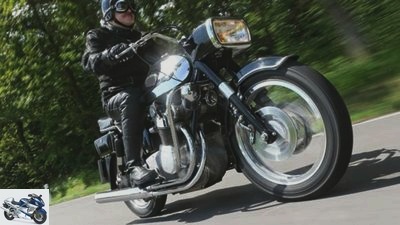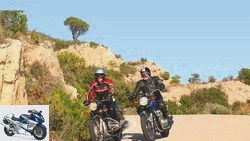Menus

Jahn
On the move: MV Agusta 600 4C
Motorcycle from the world
Content of
Riding out on a touring motorcycle, driven by a four-cylinder with a world-champion flair, like a landlord – this seemed to Count Domenico Agusta to be a good plan.
Like a street motorcycle from M.V Agusta had to look like, every Grand Prix fan knew in the mid-1960s: red as sin, with a four-cylinder racing engine, long, curved tank, seat hump, clip-on handlebars and the bare essentials that road traffic dictates.
But it was to turn out quite differently: The MV Agusta 600 4C carried a rectangular headlight the size of a bread box, chrome-plated signal horns on lush crash bars and fenders, plus a step bench for a relaxed tour for two and a wide US handlebar. Painted black, the sides of the 20 liter tank are chrome-plated. All of this would have looked good on a tourer or even a chopper, but by no means on an MV. Nevertheless, this ensemble adorned the very first production four-cylinder from the Italian manufacturer.
The 500 series turismo street version with four-cylinder engine presented in 1950 never went into series production, and it was a decade and a half before the next rollout of a street four-cylinder from Gallarate. Amazed or shocked, the fans stood in front of an MV Agusta at the Milan trade fair in 1965, which did not really fit into their worldview. Technically and optically, the engine showed its similarity to the four-cylinder MV racing machines, which under John Surtees, Gary Hocking and Mike Hailwood had won 13 titles in the 350 and 500 World Championships from 1956 to 1965. But that ended the parallels. In its bulky regalia, the 600 4C looked more like a designer accident at work.

motorcycles
On the move: BMW R 75/5, Honda CB 750
The summer of 69
read more
Jahn
MV Agusta 600 4C.
In fact, there was sober calculation at the highest level behind the deliberation. Exactly what sporty and ambitious motorcyclists managed to achieve in their imagination when they saw the 600 series, namely a sporty conversion, was what the head of the company, Conte Domenico Agusta himself, wanted to prevent at all costs. Nobody should get the idea of converting the tourer or even competing with the company’s own racing machines. This approach also explains the displacement of 600 cm³ and the cardan drive. According to the boss’s will, the 600-series MV should represent a noble tourer for a wealthy clientele and primarily appeal to American customers. The motorcycle cost 1,060,000 lire, the equivalent of around 7,500 marks. For comparison: the BMW top model, the R 69 S, was available for 4,430 marks; Munch 4 was to go on sale at 6500 marks. Only the large Harley models with 1200 cm³ exceeded the price of the MV.
The renowned brand name and the technically sophisticated inline four-cylinder alone promised a high level of exclusivity and could have aroused sporting ambitions. The engine was just as elaborately designed as the engines of the factory racing machines and, with the two overhead, gear-driven camshafts and bucket tappets, corresponded to the state of racing technology. The construction with the "banquet", MV had taken over from the racing machines that took up the crankshaft and with the help of which the completely pre-assembled engine could be placed in the housing; likewise the bearing of the steering wheels in a steel tower, which is adapted to the thermal expansion of the gears.
Technical specifications
Jahn
MV Agusta 600 4C.
MV Agusta 600 4C
Engine: Air-cooled four-cylinder four-stroke in-line engine, two valves per cylinder, two overhead, gear-driven camshafts, bucket tappets, bore 58 mm, stroke 56 mm, displacement 592 cm³, compression 9.3: 1, 52 HP at 8200 rpm, two round slide carburetors, Dell’Orto UB 24, 24 mm
Electrical system: E-starter, battery 12 V / 18 Ah, contact-controlled battery coil ignition, direct current generator, 12 V / 135 W.
Power transmission: Multi-disc oil bath clutch, dog-shift five-speed gearbox, primary drive: gear wheels, secondary drive: cardan
Landing gear: Double loop frame made of tubular steel, front Ceriani telescopic fork, rear double-arm swing arm made of tubular steel, two spring struts, wire-spoke wheels, tires front 3.50 H 18, rear 4.00 H 18, front double disc brake, 216 mm, mechanically operated floating calipers, rear simplex drum brake
Mass and weight: Length 2210 mm, wheelbase 1390 mm, seat height 810 mm, weight (dry) 221 kg, tank capacity 21 liters
Driving performance: Top speed 175 km / h
Price: 1060000 lire, approx. 7500 marks (1966)
Manufacturer: Mecchanica Verghera S. p. A., Gallarate, Italy
Related articles
-
On the move with the Kawasaki Z 650 family
wolf 38 photos wolf 1/38 A very special family outing – on the go with four different Kawasaki Z 650 models. wolf 2/38 The B1 drives beautifully…
-
Honda CB 750 Four, Munch-4 1200 TTS, MV Agusta 750 S.
Jahn 33 photos Jahn 1/33 It couldn’t be any more engine: with its transversely installed four-cylinder in-line engine, the Honda CB 750 caused a…
-
MV Agusta Brutale 800 versus Triumph Street Triple R
Jahn 15 pictures Jahn 1/15 The hot naked bikes: MV Agusta Brutale 800 and Triumph Street Triple R in a comparison test. Jahn 2/15 The …
-
Honda CB 1100 and MV Agusta Brutale 1090 in the test
Jahn 35 photos Jahn 1/35 Two bikes, two worlds. We celebrate diversity and feel the sportiness. Jahn 2/35 Ducati Streetfighter. Jahn 3/35 Aprilia Tuono….
-
Test MV Agusta F4 S Within reach It impresses with its design and it works almost perfectly. The S version of the MV Agusta F4 is an extraordinary sight…
-
Exclusive driving report MV Agusta F4 1000 Mamba T-1
Jahn Exclusive driving report MV Agusta F4 1000 Mamba T-1 Strong poison Only one person is allowed to make an MV Agusta F4 1000 lighter, faster, stronger and more elegant: …
-
On the move: Honda CB 750 Cafe Racer
Jahn 13 photos Jahn 1/13 Owner Peter Wolf can rightly be happy about his cream piece. Jahn 2/13 Two generations of Honda: Honda CB 750 Cafe Racer and…
-
Nakamura CLASSIC on the move Ducati Apollo Content of In the early 1960s, Ducati created a mighty street motorcycle with a V4 engine. His name Apollo…
-
On the move: BMW R 100 S, Honda CB 900 F Bol d’Or, Moto Guzzi Le Mans I.
fact On the move: big bikes from the 70s BMW R 100 S, Honda CB 900 F Bol d’Or, Moto Guzzi Le Mans I. Content of At the turn of the decade, MOTORRAD…
-
On the move: Moto Guzzi V7 Cafe Classic
fact On the move with the Moto Guzzi V7 Cafe Classic Yellow-green, air-cooled and spartan Content of The Guzzi eagle has offspring. Yellow-green,…